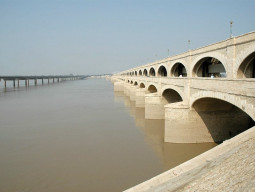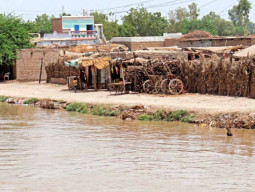
The team, comprising Irsa operations director Rana Khalid, Khyber-Pakhtunkhwa member Abdul Raqeeb Khan and Punjab member Rao Irshad Ali, also visited the Garang Regulator in Shahdadkot near Sindh-Balochistan border. Larkana irrigation chief engineer Noor Hassan Larik, executive engineer Mukhtiar Abro and other officials accompanied the Irsa delegation.
During the briefing by the Sukkur Barrage officials, the team was told that inflows in the barrage are low due to which supply to canals has been affected. The low river discharge upstream of the barrage since 2006 forced the officials to take artificial measures to maintain the pond level to ensure proper supply to the off-taking canals in the right bank, especially the North West (NW) Canal (Kirthar) which feeds Balochistan.

The measure also helped avert overtopping of water downstream of the barrage. The officials also informed the Irsa team that they need at least 150,000 cusecs of water upstream to maintain the pond level and flush out silt that collects downstream. Though they have managed to maintain the pond level but silt deposits have significantly reduced the water carrying capacity of right bank canals, the official added.
“The gauge of NW Canal is 15.1 feet and it is carrying 8,400 cusecs whereas its gauge should have been 15.2 feet and without silt it can carry 10,000 cusecs of water,” said Abdul Aziz Soomro, Sukkur Barrage control room in-charge.
In 1932, 10 gates of the barrage were closed and a channel was provided between gate no. 15 and 22 to flush out silt. The measure reduced the discharge capacity of Sukkur Barrage from 1.5 million cusecs to 900,000 cusecs. The problem of silt deposit in the right bank was, however, solved. According to Irrigation department sources, due to low water discharge the silt is not being flushed through the channel and this has affected the capacity of right bank canals, particularly NW Canal.
They further said that Irsa is only concerned about filling up the Tarbela and Mangla dams and this leaves barrages in Sindh without adequate water, especially in the critical Kharif months of May, June and July. “The pond level of Tarbela Dam is 1,405 feet and only 45 feet more water is required to fill it to its full capacity even though the deadline to fill it is August 20,” a source said, adding if they release water from Tarbela in May, June and July it would not only enhance power generation but also meet growers’ needs. “Irsa releases water in August when no one needs it because of monsoon rains.”
Huge water theft by influential landlords was also cited as one of the main reasons of water shortage. “The landlords are far more powerful than the irrigation officials,” a source said.
“Three years ago, a son of an irrigation department employee was shot dead because the official was regulating the water as per schedule and refused to obey the orders of the influential.”
Following the conclusion of the visit, both Khalid and Ali evaded questions while Khan told The Express Tribune that all Sindh barrages are being provided water according to the indent.
Published in The Express Tribune, July 9th, 2013.


















1714034954-0/WhatsApp-Image-2024-04-25-at-1-48-04-PM-(1)1714034954-0-270x192.webp)



















COMMENTS
Comments are moderated and generally will be posted if they are on-topic and not abusive.
For more information, please see our Comments FAQ